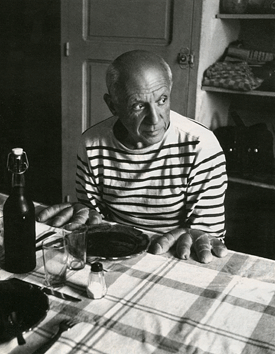PDN Magazine - May 2006
End Frame
A Portrait of the Artist as a Man Who Plays with His Food
As any fan of the works of Robert Doisneau knows, this month's cover photo, a portrait of actor/writer Steve Martin taken by Chris Buck for Premiere, is an homage to the French master's classic 1952 portrait of Pablo Picasso. Picasso is a hero to Martin, the author of the play "Picasso at the Lapin Agile."
The idea to channel the spirit of the Doisneau image came from Linda Liang, Associate Photo Editor at Premiere. The magazine was running a long interview with Martin, who was promoting Shopgirl, a film he wrote and starred in, and Buck and Liang had to come up with portrait ideas.
Two days before the shoot, Liang says, "I was in yoga class and I looked down at my hands. I thought: 'Bread hands!'" She found a copy of the Doisneau photo and forwarded it to Martin's publicist. "She immediately wrote back to say that [Martin] loves this photo," Liang says.
Liang thought the idea of putting Martin in place of Pablo Picasso worked with the story. "Steve Martin is a man of culture, and Shopgirl reflects that. This concept would allow us to show that he himself is creative and whimsical, that he's funny, but not stupid or goofy."
Buck, however, had some trepidation. The original, he says, "is classic Doisneau, it's playful surrealism. It's silly but it's smart at the same time." If he didn't strike the same balance, he feared, "It could look just silly."
Buck was told he had only half an hour with his subject. Prop stylist Liz Engelhardt gathered bread loaves at different sizes before the shoot, which took place at the Regency Hotel in New York. Once Martin was in wardrobe and seated at the table, Liang says, "He and Chris collaborated well together, coming up with variations." In place of the casual country kitchen, Martin appears to be seated in a formal restaurant. Instead of Picasso's far-off and rueful look, Martin frowned, making himself look mournfully abashed.
"When you're doing a picture like this, at some point you have to throw away the reference picture," says Buck. He adds, "It's meant to be a standalone picture. If you recognize the reference, that's great. If you don't, it will still be a curious image."


